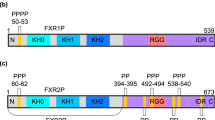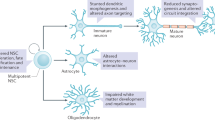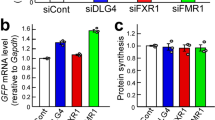Abstract
THE fragile X syndrome is the most frequent form of inherited mental retardation after Down's syndrome, having an incidence of one in 1,250 males1,2. The fragile X syndrome results from amplification of the CGG repeat found in the FMR-1 gene3–6. This CGG repeat shows length variation in normal individuals and is increased significantly in both carriers and patients3–6; it is located 250 base pairs distal to a CpG island6 which is hypermethylated in fragile X patients4–7. The methylation probably results in downregulation of FMR-1 gene expression8. No information can be deduced about the function of the FMR-1 protein from its predicted sequence. Here we investigate the nature and function of the protein encoded by the FMR-1 gene using polyclonal antibodies raised against the predicted amino-acid sequences. Four different protein products, possibly resulting from alternative splicing, have been identified by immunoblotting in lymphoblastoid cell lines of healthy individuals. All these proteins were missing in cell lines from patients not expressing FMR-1 messenger RNA. The intracellular localization of the FMR-1 gene products was investigated by transient expression in COS-1 cells and found to be cytoplasmic. Localization was also predominantly cytoplasmic in the epithelium of the oesophagus, but in some cells was obviously nuclear.
This is a preview of subscription content, access via your institution
Access options
Subscribe to this journal
Receive 51 print issues and online access
$199.00 per year
only $3.90 per issue
Buy this article
- Purchase on Springer Link
- Instant access to full article PDF
Prices may be subject to local taxes which are calculated during checkout
Similar content being viewed by others
References
Gustavson, H. K., Blomquist, H. & Holgrem, G. Am J. med. Genet. 23, 581–588 (1986).
Webb, T. P., Bundey, S. E., Thake, A. I. & Todd, J. Am. J. med. Genet. 23, 573–580 (1986).
Verkerk, A. J. M. H. et al. Cell 65, 905–914 (1991).
Oberlé, I. et al. Science 252, 1179–1181 (1991).
Yu, S. et al. Science 252, 1179–1181 (1991).
Fu, Y.-H. et al. Cell 67, 1047–1058 (1991).
Heitz, D. et al. Science 251, 1236–1239 (1991).
Pieretti, M. et al. Cell 66, 817–822 (1991).
Smith, D. B. & Johnson, K. S. Gene 67, 31–40 (1988).
Merrifield, R. B. J. Am. chem. Soc. 85, 2149–2154 (1963).
Verkerk, A. J. M. H. et al. Hum. molec. Genet. 2, 399–404 (1993).
Green, S., Isseman, I. & Sheer, E. Nucleic Acids Res. 16, 369 (1988).
Hinds, H. L. et al. Nature Genet. 3, 36–43 (1993).
Auffray, C & Rougeon, F. Eur J. Biochem. 107, 303–314 (1980)
DeBoulle, K. et al. Nature Genet. 3, 31–35 (1993).
Oshima, A. et al. J. biol. Chem. 263, 2553–2562 (1988).
Van Dongen, J. M., Barneveld, R. A., Geuze, H. J. & Galjaard, H. Histochem. J. 16, 941–954 (1984).
Author information
Authors and Affiliations
Rights and permissions
About this article
Cite this article
Verheij, C., Bakker, C., de Graaff, E. et al. Characterization and localization of the FMR-1 gene product associated with fragile X syndrome. Nature 363, 722–724 (1993). https://doi.org/10.1038/363722a0
Received:
Accepted:
Issue Date:
DOI: https://doi.org/10.1038/363722a0
This article is cited by
-
Development of prefrontal cortex
Neuropsychopharmacology (2022)
-
A Highly Selective MNK Inhibitor Rescues Deficits Associated with Fragile X Syndrome in Mice
Neurotherapeutics (2021)
-
FMR1 locus isoforms: potential biomarker candidates in fragile X-associated tremor/ataxia syndrome (FXTAS)
Scientific Reports (2020)
-
The role of polygenic risk score gene-set analysis in the context of the omnigenic model of schizophrenia
Neuropsychopharmacology (2019)
-
Expression of BC1 Impairs Spatial Learning and Memory in Alzheimer’s Disease Via APP Translation
Molecular Neurobiology (2018)
Comments
By submitting a comment you agree to abide by our Terms and Community Guidelines. If you find something abusive or that does not comply with our terms or guidelines please flag it as inappropriate.



